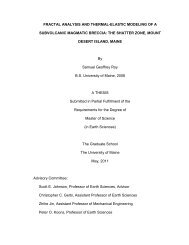Responses of Benthos to Changing Food Quality and Quantity, with ...
Responses of Benthos to Changing Food Quality and Quantity, with ...
Responses of Benthos to Changing Food Quality and Quantity, with ...
You also want an ePaper? Increase the reach of your titles
YUMPU automatically turns print PDFs into web optimized ePapers that Google loves.
<strong>Responses</strong> <strong>of</strong> <strong>Benthos</strong> <strong>to</strong> <strong>Changing</strong> <strong>Food</strong> <strong>Quality</strong> <strong>and</strong> <strong>Quantity</strong> 245<br />
species <strong>to</strong> make a net pr<strong>of</strong>it from deposit feeding at a depth below the<br />
sediment-water interface, where the costs <strong>of</strong> producing burrows otherwise<br />
would not repay the costs <strong>of</strong> making them (Griggs et al . 1969) . Animals in<br />
effect "mine" the "coal seams" produced by the event . There is not a piece<br />
<strong>of</strong> benthic sampling gear in existence that is well designed <strong>to</strong> capture large<br />
<strong>and</strong> deep burrowers, but shallow-water representatives (e .g ., thalassinid<br />
shrimp) easily can exceed 2 m depth below the sediment-water interface<br />
(Dworschak 1983), <strong>and</strong> we <strong>and</strong> other deep-sea biologists <strong>and</strong> geologists<br />
routinely see open tubes <strong>and</strong> burrows coming out the bot<strong>to</strong>ms <strong>of</strong> 50 cmlong<br />
box cores taken from turbidites . An interesting question is whether<br />
these deep burrowers must be preceded by a sequence <strong>of</strong> shallower<br />
burrowers . Alternatively, they might find such events through the nonsteady<br />
state migration <strong>of</strong> pore waters (Sorensen et al . 1987) . In either case it is<br />
not clear how the deep burrower grows large enough <strong>to</strong> reach the organicrich<br />
deposit unless seams outcrop . It would appear pr<strong>of</strong>itable in view <strong>of</strong> all<br />
these unknowns <strong>to</strong> study living faunas <strong>and</strong> trace fossils in turbidites having<br />
varying vertical <strong>and</strong> horizontal structures <strong>and</strong> oxygenation his<strong>to</strong>ries .<br />
Evolution<br />
Clearly the most underexplored time scale for paleoceanographic purposes<br />
is the evolutionary one (from generation time upward) . The level <strong>of</strong><br />
resolution in most stratigraphic records gives little information on shorterterm<br />
phenomena (Schindel 1980) . The key issue is whether one can identify<br />
characteristics <strong>of</strong> individuals, populations, <strong>and</strong> communities that reflect the<br />
local mean <strong>and</strong> variation <strong>of</strong> organic input . The goal from a biologist's<br />
perspective would be <strong>to</strong> predict the sizes, abundances, <strong>and</strong> types <strong>of</strong> organisms<br />
expected <strong>to</strong> evolve at or invade a site given its vertical inputs <strong>and</strong> horizontal<br />
transports <strong>of</strong> food . That goal is very distant, but as it is approached it will<br />
provide a strong means <strong>of</strong> converting paleon<strong>to</strong>logical evidence in<strong>to</strong><br />
paleoproductivity estimates . Despite the distance <strong>of</strong> the goal, it is clear that<br />
effects <strong>of</strong> millenial increases in productivity over broad reaches <strong>of</strong> the ocean<br />
floor do not parallel anthropogenous loadings . Equa<strong>to</strong>rial deep-sea benthic<br />
faunas are neither dramatically low in diversity nor do they comprise<br />
exclusively small, shallow-burrowing individuals .<br />
This empirical approach <strong>of</strong> comparing present-day faunas from disparate<br />
vertical <strong>and</strong> horizontal flux regimes, assuming that these faunas have evolved<br />
<strong>to</strong> some near-equilibrium <strong>with</strong> their present food supplies, can provide other<br />
insights as well . For the deep sea, however, this effort is hampered by lack<br />
<strong>of</strong> published information on geographic distribution <strong>of</strong> infaunal species .<br />
Community structure appears similar under the oligotrophic gyres <strong>of</strong> the<br />
North <strong>and</strong> South Pacific <strong>and</strong> quite different from that <strong>of</strong> the equa<strong>to</strong>rial zone
















